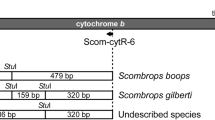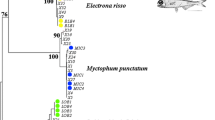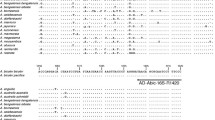Abstract
Cytochrome b has been successfully employed for genetic identification of four species of anchovies (Engraulis spp) using two methodologies: PCR–RFLP and FINS. The first method allowed the identification of Engraulis anchoita, Engraulis ringens and Engraulis japonicus–Engraulis encrasicolus. In some cases, with a determined restriction profile, this technique was able to differentiate E. japonicus from E. encrasicolus. The second method allowed the identification of those four species and demonstrates that FINS is a suitable technique for the identification of all species studied in this work. Phylogenetic trees show that sequences of E. encrasicolus are grouped into two different clusters. These results are consistent with the previously published data which suggest that some species of genus Engraulis could be cryptic species, being one specie or population distributed in the oceanic habitat and the other one around the coast.




Similar content being viewed by others
References
Bembo DG, Carvalho GR, Snow M et al (1996) Stock discrimination among European anchovies, Engraulis encrasicolus, by means of PCR-amplified mitochondrial DNA analysis. Fish Bull 94:31–40
Levi D, Andreoli MG, Arneri E et al (1994) Otolith reading as a tool for stock identification. Fish Res 20:97–107
Magoulas A, Tsimenides N, Zouros E (1996) Mitochondrial DNA phylogeny and the reconstruction of the population history of a specie: the case of the European anchovy (Engraulis encrasicolus). Mol Biol Evol 13:178–90
Borsa P (2002) Allozyme, mitochondrial-DNA, and morphometric variability indicate cryptic species of anchovy (Engraulis encrasicolus). Biol J Linn Soc 75:261–269
Borsa P (2004) Nuclear-DNA markers confirm the presence of two anchovy species in the Mediterranean. C R Biol 327:1113–1123
Chiu TS, Lee YJ, Huang SW, Yu HT (2002) Polymorphic microsatellite markers for stock identification in Japanese anchovy (Engraulis japonica). Mol Ecol Notes 2:49–50
Sebastio P, Zanelli P, Neri TM (2001) Identification of anchovy (Engraulis encrasicholus L.) and gilt sardine (Sardinella aurita) by polymerase chain reaction, sequence of their mitochondrial cytochrome b gene, and restriction analysis of polymerase chain reaction products in semipreserves. J Agric Food Chem 49:1194–1199
Pérez RM, Álvarez C, Balado M et al (2004) Identification of south Atlantic Hakes (Merluccius australis and Merluccius hubbsi) in processed foods by PCR-RFLPs of cytochrome bgGene. Aquat Food Prod Technol 13:59–67
Pérez Rodríguez M Calibrado y aplicación de marcadores moleculares para el diagnóstico genético de stocks productos y subproductos de merluza, Merluccius spp. 2003 Doctoral Thesis, Departamento de Bioquímica, Genética e Inmunología, Universidad de Vigo
Sotelo CG, Calo-Mata P, Chapela MP et al (2001) Identification of flatfish (Pleuronectiformes) species using DNA-based techniques. J Agric Food Chem 49:4562–4569
FAO Fisheries Departament. FAO Species catalogue, Clupeoid fishes of the world (Suborder Clupeoidei). An annotated and illustrated catalogue of herrings, sardines, pilchards, sprats, shads anchovies and wolf-herrings. Vol. 7, Part 2 Engraulididae
McCarthy C Chromas version 1.45 (32 bit). School of health Science. Griffith University, Gold Coast Campus, Southport, Queensland, Australia
Hall TA (1999) BioEdit: a user-friendly biological sequence alignment editor and analysis program for Windows 95/98/NT. Nucleic Acids Symp Ser 41:95–98
Barlett SE, Davidson WS (1992) FINS (forensically informative nucleotide sequencing): a procedure for identifying the animal origin of biological specimens. Biotechniques 12:408–411
Phylogenetic and molecular evolutionary analyses were conducted using MEGA version 3.0 (Kumar, Tamura, Nei 2004)
Rozas J, Sánchez-Del Barrio JC, Messseguer X et al (2003) DnaSP, DNA polymorphism analyses by the coalescent and other methods. Bioinformatics 19:2496–2497
Grant SW (2005) A second look at mitochondrial DNA variability in European anchovy (Engraulis encrasicolus): test of the “basin” model and Black Sea isolation hypotesis. Genetica (in press)
Grant SW, Robin WL, Brian WB (2005) Molecular genetic assessment of bipolarity in the anchovy genus Engraulis. J Fish Biol 67:1–24
Acknowledgments
We would like to thank Cristina Sotelo, Fernando Alonso, Inspectors from Sanidad Exterior (Vigo) and others for kindly providing samples, and Montserrat Espiñeira and Marina C. Gaviño for their helpful assistance.
Author information
Authors and Affiliations
Corresponding author
Rights and permissions
About this article
Cite this article
Santaclara, F.J., Cabado, A.G. & Vieites, J.M. Development of a method for genetic identification of four species of anchovies: E. encrasicolus, E. anchoita, E. ringens and E. japonicus . Eur Food Res Technol 223, 609–614 (2006). https://doi.org/10.1007/s00217-005-0241-5
Received:
Revised:
Accepted:
Published:
Issue Date:
DOI: https://doi.org/10.1007/s00217-005-0241-5




